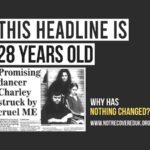13 to 19 November marks Transgender Awareness Week (TAW). These are the seven days leading up to Transgender Day of Remembrance (TDoR), 20 November, when vigils are held to remember the lives lost to transphobia. The intention of TAW itself is to improve the visibility of trans communities and the issues they face.
Hyper-visibility
Of course, these past few years, one of the few things the trans community – my community – hasn’t lacked is visibility. Barely a day has gone by in which the mainstream media hasn’t run something on trans people. Usually, this has an overwhelmingly negative framing. Prime minister Rishi Sunak and the Tory Party are happy to exploit transphobia for political gain, and Labour isn’t far behind them. Trans communities are currently hyper-visible, spoken of and spoken over painfully often.
We can see this same effect play out on Twitter. It’s something of a running joke among trans people that any day when a transphobic hashtag isn’t trending is a cause for celebration. In spite of this, Twitter functions as something of a hub and meeting place for trans people across the world. It is one of the main online spaces where the possibility of living as a trans person is fully displayed. It’s a platform where we can find and speak to one another directly.
As such, trans twitter has been an important tool and formative part of many trans people’s journeys – my own included. This is why the takeover of twitter by billionaire Elon Musk on 28 October has sent dread rippling through the online trans community.
Elon Musk
Musk’s takeover was accompanied by promises to bring “free speech” to the platform, and to allow accounts which were banned for the harassment of marginalised people back onto the site. This was marked by an immediate uptick in the quantity of hate speech and discrimination – for trans people and many other marginalised groups. ‘Free speech’ absolutism, as always, functions as explicit permission for bigots to spew right-wing bile without the fear of consequences.
Twitter’s moderation of transphobia within its domain has always been patchy, at best. However, Musk appears to be motivated by a very specific desire to remove what little protections exist for trans people on the social network. What’s more, his dislike for trans communities has been plain to see for some time now.
First off, one of Musk’s own daughters is trans – and completely estranged from the new Twitter mogul. Musk has publicly blamed his non-existent relationship with his daughter on indoctrination by “communist” universities. He said:
It’s full-on communism… and a general sentiment that if you’re rich, you’re evil.
He also went on to add:
It [the relationship] may change, but I have very good relationships with all the others [children].
Of course, I’m sure that his open dislike towards the marginalised community to which his daughter belongs has nothing to do with their estrangement.
A snapshot of transphobia
Back in 2020, Musk – a prolific Twitter user himself – tweeted that “pronouns suck” and are an “esthetic [sic] nightmare” on personal profiles. At the time, his then-wife – musician/producer Grimes – publicly told him:
I cannot support this hate. Please stop this.
As part of Musk’s desperate ‘edgelord’-style humour, he’s used Twitter to mock trans representation in film and television. He’s also attacked the necessity of gender-affirming surgeries for trans people. In a Twitter thread concerning the infamously trans-hostile What is a Woman? documentary by far-right blowhard Matt Walsh, Musk responded:
“We are simultaneously being told that gender differences do not exist and that genders are so profoundly different that irreversible surgery is the only option.”
He has also liked the tweets of and defended the deeply transphobic ‘Libs of Tiktok’ account. Libs of Tiktok directs hate towards LGBT+ individuals and advocacy groups, often calling them “groomers”. Most notably, it tweeted a video of a gynaecologist explaining gender-affirming hysterectomy – having attached the caption “Boston Children’s Hospital is now offering ‘gender-affirming hysterectomies’ for young girls”. This was an utter fabrication. Although the tweet was later taken down, it had already caught on with right-wing influencers and media outlets. This eventually resulted in Boston Children’s Hospital receiving bomb threats.
Plans for the platform
The new Twitter boss has already set about creating a de-regulated iteration of the platform. Twitter workers have already been locked out of back-end controls which govern the moderation of hate speech and misinformation. Employees have also been directed to review the content moderation policies – including those on the “targeted misgendering or deadnaming of transgender individuals”. The extent of the coming alterations to the moderation policy are as-yet unknown.
In response to a tweet asking if Jordan Peterson – a far-right talking head banned for deadnaming Elliot Page, amongst other offences – would be reinstated onto Twitter, Musk responded:
Anyone suspended for minor & dubious reasons will be freed from Twitter jail.
The plans for Musk’s reign over Twitter have already caused concern among advocacy organisations. Human Rights Campaign stated:
Musk has pledged to restore the accounts of dangerous people who push extremism and disinformation. When this happens, Twitter – a place where many marginalised people, including LGBTQ+ people, find both community and face an onslaught of hate – will quickly become even more hostile.
Michael Kleinman, Director of Technology and Human Rights for Amnesty International USA, also said in a statement:
The last thing we need is a Twitter that willfully turns a blind eye to violent and abusive speech against users, particularly those most disproportionately impacted, including women, non-binary persons, and others.
It seems increasingly true that Twitter won’t last much longer. Even if it does, the chances of unregulated harassment rendering it unusable for queer people are very high. This comes as such a blow for the trans communities present on the platform because it was, for many of us, the first way we found out about the possibility of life as a trans person.
Trans Twitter
Over half of all Twitter users are aged 25-49. This means that, in the UK, most of us grew up during Section 28 – the Thatcherite prohibition against the ‘promotion’ of homosexuality in schools. In our youth, trans people only appeared as the punchline of a joke, a victim or a villain on television. Even today, less than a decade after the ‘trans tipping point’ – the slow drip of positive trans representation in the media – it’s still difficult to understand how being trans could be possible for oneself.
Trans Twitter became one of the main places where we could see normal people living their lives whilst also being trans. It became a place where we could seek advice on how to talk to doctors, how to legally change our names, how to tell our family who we are. The platform functioned as a comparison site for people’s experiences with surgeons, psychiatrists, and endocrinologists. It was a whisper network to provide warning of which doctors were too handsy, which clinicians would ask invasive questions, which prescribers only offered sub-normal doses of hormone replacement therapy (HRT).
Connection and community
All of this was necessary because, without finding real-life community, the information simply wasn’t readily available without social media. During the coronavirus (Covid-19) lockdowns, many of us became more crushingly isolated than ever before. For those trapped at home with unsupportive family, trans Twitter became a lifeline.
At a point in time when the mainstream media rarely has a good word to say about trans people, Twitter was somewhere to find relevant news, directly from those most affected by bathroom bans, HRT shortages, and court cases won or lost. It offered tips on how to get a binder that fits, how to do eyeliner for a hooded eyelid, or how to show up to work again the day after your packer fell out the leg of your trousers. Hell, if the number of people I know who met on the platform is anything to go by, Twitter was the world’s premier transgender dating website.
Timelines
On a more personal level, I’m unsure that I would have reached this point in my life without the level of visibility provided by trans Twitter. Even if you grew up feeling like some unique kind of alien, the Twitter algorithm could find five people with your gender experience, micro-interests, and fashion sense. The arc of my own transition was mildly unusual. I started the long, slow process of coming out as non-binary around 10 years ago. First to my fiancé, then close friends, family, the world at large. But it wasn’t until I saw other non-binary people on Twitter talking about using HRT that I accepted it was still something I could want for myself, even without conceiving of myself as a woman.
When I decided to pursue HRT, nearly 3 years ago, one of the first people I told was fellow Canary staffer Maryam Jameela. Maryam said something like ‘Duh, all you’ve liked on Twitter for the last year is transition timelines’. The bird app has this annoying habit of displaying things you’ve liked to the people who follow you. But, I checked, and it was true. My likes were selfie after selfie of trans men, women, non-binary people, all of them showing their progress in transition. There is a light that comes into people as their dysphoria lifts that you can see, even in a still image. It’s a feeling I couldn’t trade for the world.
Goodbye, friends
Trans Twitter, like Twitter as a whole, has its problems – major and minor. We’re given to a revolving carousel of discourse, infighting, and overly public breakups. It’s a hellsite that exposed many of us to more overt transphobia than we’d experienced even in our daily lives. However, most of us stuck around because, on some level, we needed to. We needed to read about other trans people and their experiences. Twitter offered visibility, connection, and community. For that, at least, I’m thankful to the stupid bird app.
Featured image via Wikimedia Commons (public domain), and Wikimedia Commons/Twitter via Apache License 2.0 – logo overlayed on flag, resized to 770×403
















